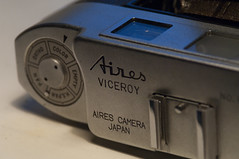The Aires Viceroy is a folding 6×6 coupled-rangefinder camera that Aires produced for export to India (some sources say southeast Asia) around 1957–8.[1] The body was manufactured by Takane and was based on that for the Mine Six (and indirectly on that for the Mihama Six), the finder and the lens assembly were manufactured by Aires (they were designed by Kodera Keiji).[2]
Description
 
|
| Aires Viceroy no.670655, Coral 75mm f/3.5 lens, Seikosha-MX shutter. Pictures courtesy of Robbie Verhagen. (Image rights) |
The main body is identical to the body of the Mine Six IIF, including the camera back with two red windows. The Viceroy is dual format and can take both 6×6 and 4.5×6 exposures, and the film advance is manually controlled. Only the leather covering has different patterns and markings: the AIRES CAMERA logo is embossed on the front door, MADE IN JAPAN on the back latch and perhaps something else next to the red windows.
The top cover differs from the Mine Six models. It contains a combined range and view-finder, with the eyepiece offset to the left and a bright frame, illuminated by an additional translucent window in the middle. The internal design of this finder is certainly similar to that of the Aires 35 II and III. The advance knob and body release are on the right and there is a film reminder on the left. The model name (Aires VICEROY), the company name (AIRES CAMERA JAPAN), the serial number and the film plane indicator are engraved above the top housing, on both sides of the accessory shoe.
  
|
  
|
| Pictures courtesy of Robbie Verhagen. (Image rights) |
The Viceroy has a 75mm f/3.5 lens: either a three-element Coral (produced by Aires) or a four-element Nikkor.[3] It is unit-focussed: the entire lens and shutter assembly is mounted on the focusing helical, not merely the frontmost element. The shutter is a Seikosha-MX giving B, 1–500 speeds, with a self-timer and a PC synch post.
The leather case is prominently embossed VICEROY and has the same AIRES CAMERA logo as the camera's folding bed.
All the numbers for the body and Coral lenses observed so far are in the 670xxx and 671xxx range.[4] Total production was certainly between 1,000 and 2,000.
  
|
  
|
   
|
| Aires Viceroy no.670756, Coral 75mm f/3.5 lens no.670252, Seikosha-MX shutter. Pictures by JPG. (Image rights) |
Notes
- ↑ Southeast Asia: Kokusan kamera no rekishi, p.376. Date: Hagiya, p.6 of Kurashikku Kamera Senka no.22, and Hattori, p.14 of the same magazine, say 1957. Kokusan kamera no rekishi, p.376, says that the Viceroy was featured in Sankei Camera October 1958.
- ↑ Hagiya, p.6 of Kurashikku Kamera Senka no.22.
- ↑ Number of elements: Hattori, p.14 of Kurashikku Kamera Senka no.22.
- ↑ Observed body numbers: lowest 670655, highest 671714. Observed numbers for the Coral lens: lowest 670117, highest 671160.
Sources / further reading
- Asahi Camera (アサヒカメラ) editorial staff. Shōwa 10–40nen kōkoku ni miru kokusan kamera no rekishi (昭和10–40年広告にみる国産カメラの歴史, Japanese camera history as seen in advertisements, 1935–1965). Tokyo: Asahi Shinbunsha, 1994. ISBN 4-02-330312-7. Item 1088. (This book does not reproduce any advertisement for the Viceroy, which was for export only.)
- Christies auction catalogue: "Fine and Rare Cameras", 5 November 1992, lot 253.
- Hagiya Takeshi (萩谷剛). "Airesu kamera no rekishi" (アイレスカメラの歴史, History of the Aires cameras). Kamera Rebyū: Kurashikku Kamera Senka (カメラレビュー クラシックカメラ専科) / Camera Review: All about Historical Cameras no.22, September 1992. No ISBN number. Airesu no subete (アイレスのすべて, special issue on Aires). Pp.4–7. Based on interviews of Mitsuhashi Gō (三橋剛), founder of Aires and of Kodera Keiji (小寺桂次), an engineer who worked in the company.
- Hagiya Takeshi (萩谷剛). "Airesu no kamera: Yarūfurekkusu soshite 6×6-han niganrefu, 35mm kamera e" (アイレスのカメラ:ヤルーフレックスそして6×6判二眼レフ、35mmカメラへ, The Aires cameras: From the Yallu Flex to 6×6 TLRs and 35mm cameras). Chapter 5 of Zunō kamera tanjō: Sengo kokusan kamera jū monogatari (ズノーカメラ誕生:戦後国産カメラ10物語, The birth of the Zunow camera: Ten stories of postwar Japanese camera makers). Tokyo: Asahi Sonorama, 1999. ISBN 4-257-12023-1.. In Japanese only. Essentially a re-publication of the previous article "Airesu kamera no rekishi".
- Hagiya Takeshi. "Mine Shikkusu: Gunma-ken Takasaki-shi no kameramēkā" (ミネシックス:群馬県高崎市のカメラメーカー, Mine Six: A camera-maker in Takasaki, Gunma). Chapter 7 of Zunō kamera tanjō: Sengo kokusan kamera jū monogatari (ズノーカメラ誕生:戦後国産カメラ10物語, The birth of the Zunow camera: Ten stories of postwar Japanese camera makers). Tokyo: Asahi Sonorama, 1999. ISBN 4-257-12023-1.. First published in Kurashikku Kamera Senka no.27 (December 1993). On the manufacture by Takane and the reason for this.
- Hattori Yutaka (服部豊). "Airesu kamera no subete — 6×6-han supuringu-kamera" (アイレスカメラのすべて・6×6判スプリングカメラ, "All of Aires cameras — 6×6 folding camera"). Kamera Rebyū: Kurashikku Kamera Senka (カメラレビュー クラシックカメラ専科) / Camera Review: All about Historical Cameras no.22, September 1992. No ISBN number. Airesu no subete (アイレスのすべて, special issue on Aires). P.14.
- McKeown, James M. and Joan C. McKeown's Price Guide to Antique and Classic Cameras, 12th Edition, 2005-2006. USA, Centennial Photo Service, 2004. ISBN 0-931838-40-1 (hardcover). ISBN 0-931838-41-X (softcover). P.44.
This camera is not listed in Sugiyama.
Links

|
| Picture by GeBuSoFoTo. (Image rights) |
In English:
- Aires Viceroy in a page about Aires and with other folding cameras at Nekosan's website
- Aires Viceroy among other cameras at Cameras Downunder
- Aires Viceroy, lot no.792 of auction no.14 (November 30, 2008) by Westlicht Photographica Auction
In English and in Italian
- Aires camera survey by Massimo Bertacchi (the Viceroy is at the bottom of the page)
In French:
- Aires Viceroy at Sylvain Halgand's www.collection-appareils.fr
In Japanese:
- Aires Viceroy (Nikkor lens) in the AJCC website
- Page of wanted cameras with an Aires Viceroy (Coral lens) at je2luz
